END OF LIFE UPDATE: Summer 2013 - The X58 MSI Eclipse motherboard eventually died an all to common death for MSI boards from this generation: it simply failed to boot up. No POST, no video.... no life. The Port 80 card displayed an "FF", signalling the CPU was failing to initialise. The CPU was tested on another board - ok, the 1.65v triple channel DDR3 memory was tested on another board - ok, different amounts of memory modules were tried - no luck, a tested working powersupply was installed - no luck, video card was swapped out - no luck. Funnily enough, the damn southbridge continued to overheat though... LOL. As MSI Computer knows, sometimes overkill is a good thing. This seems
to be the philosophy behind the MSI X58 Eclipse Plus motherboard - a jet black beauty built
around Intel's X58 Express and ICH10R chipsets for the Intel Core i7 family of
socket 1366 processors. While a few motherboards based on the X58 Express chipset are available
in the upper-midrange, the MSI Eclipse Plus is purposefully,
and fully created to satisfy the needs of the ultra-high-end-double-stamp-it-no-erasies PC enthusiast
we all secretly envy. In short, this is one fantastic motherboard.
Standard to any Intel X58 Express motherboard is a new
technology called the QuickPath Interconnect interface, it has a maximum
bandwidth of 6.4 GT/s, and 36 lanes of PCI Express bandwidth at its disposal.
The MSI X58 Eclipse Plus goes one step further however, adding a second chipset,
the NVIDIA nForce 200 SLI chipset into the mix. This secondary chipset brings
another 32 lanes of PCI Express 2.0 bandwidth to the graphics subsystem.
All of this bandwidth is
split up into a trio of PCI Express 2.0 x16 slots, each of which has x16 lanes
of bandwidth. The fourth PCI Express x16 slot has x4 lanes of PCI Express 2.0
bandwidth, but MSI kind of obscure that fine point. The X58 Eclipse Plus has the
benefit of supporting both NVIDIA SLI multi-graphics card configurations and AMD's Crossfire X. In other words,
it's possible to install three full size nVidia Geforce graphics cards or two
full size ATI Radeon videocards and team them up for utterly fantastic gaming
performance.
The MSI X58 Eclipse Plus is only compatible
with Intel socket 1366 Core i7 processors. There are a handful of 'Bloomfield'
core processors built for this socket such as the Core i7 920, 940,
950, 960 and 965/975 Extreme Edition chips. Similarly, only the socket
1366 Core i7 9-series processors will do, 'Lynnfield' Core i7
8-series CPUs are meant for mainstream socket 1156
platforms like the P55 Express even though they share the Core i7 moniker.
MSI's
X58 Eclipse Plus motherboard supports DDR3 memory exclusively, and triple channel kits at that. The board will accommodate up to 24GB of DDR3-800/1066/1333 (DDR3-1600 overclocked) RAM in its six
physical memory slots. Of course, that's for Windows XP/Vista/7 64-bit operating systems, all Windows 32-bit
OSes are limited to an effective maximum of 6GB. For those that invested early in dual-channel DDR3 memory kits
you may be able to re-use the memory, the Eclipse Plus will run with
dual channel memory installed. This divides the six memory banks into two sets of three,
which should provide better bandwidth and fewer memory bottlenecks.
 |
|
MSI X58 Eclipse Plus
Motherboard |
|
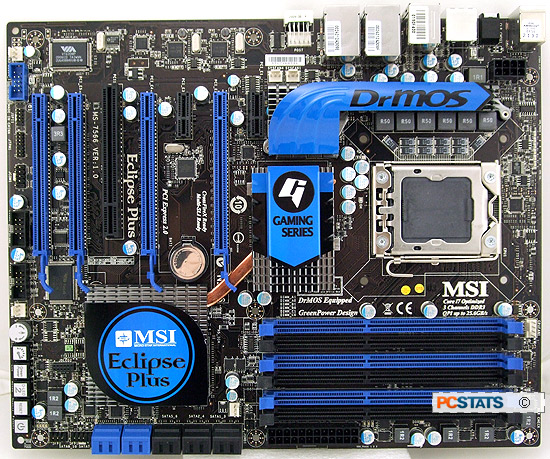

|
|
|
|
INCLUDES: User's Manual,
Quickstart guide, Soundblaster guide, HDD backup guide, Driver
CDs, (8) click-connect Serial ATA cables, (4) Molex to Serial
ATA Power Cables, X-FI Audio Card, Green Power Genie, MSI
D-LED 2, 24-pin Power connector Brige, 2-port USB Brackets,
2-port eSATA bracket, eSATA power cable, eSATA data cable,
mid-board connectors, thermal sensor, I/O shield, 3x SLI
connectors, 3x Crossfire connectors.
|
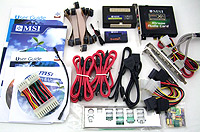
|
|
Chipsets: Intel X58
Express
CPU Support: Intel Socket
1366
Memory Type: Triplel Channel
DDR3-800/1066/1333/1600
Videocard Support:
(3) PCI Express x16 2.0
Integrated Graphics:
No | |
| |
In terms of storage, there are no less than twelve
3GB/s SATA ports, six of which are SATA II connections powered by the ICH10R
southbridge that includes RAID 0/1/5/10 support. A pair of JMicron JMB322
controllers operate four more SATA II ports with options for RAID 0/1 and JBOD,
and two eSATA ports can be configured in RAID 0/1 or JBOD mode. There are
no IDE connections (nor FDD) on this motherboard, so a
SATA-based optical drive is the only ticket.
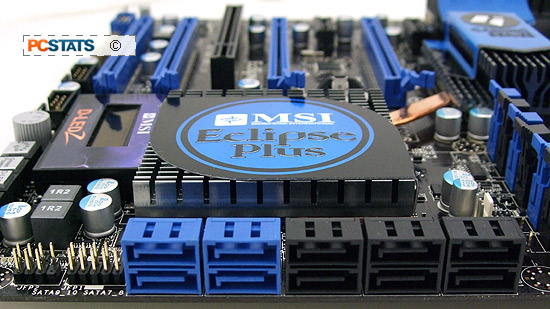
Peripherals can be installed into one of three PCI
Express x16 2.0 slots, one PCI Express x16 slot running in x4 2.0 mode, two PCI
Express x1 slots or the lone legacy PCI slot. Expansion Around back on the I/O
panel users will find two eSATA ports, two gigabit network ports, a Firewire
jack, eight USB ports, a Port-80 display and CMOS reset button. MSI's X58
Eclipse Plus motherboard retails for around $400 CDN, ($389 USD, £245 GBP) , but that's not all it comes
with....
Features a Plenty on the Eclipse
There's a lot more to MSI's X58 Eclipse Plus motherboard than just the core
components that go into most Intel X58 motherboards. MSI has done a lot to take
this motherboard that extra mile. For starters, rather than stick with a
traditional Azalia-based audio codec, they've collaborated with Creative Labs to
include a Sound Blaster X-fi Xtreme Audio PCI Express audio daughtercard.
Switching
from on-board audio to a discrete audio card reduces electrical interference
from the motherboard, which in turn improves signal-to-noise ratios. The result
is less hiss and noise when recording audio or playing it back. The included
X-Fi card is also shielded to further reduce interference. Audio output
is split up between eight-channel stereo output and an
S/PDIF audio output. The X-Fi Xtreme Audio Card has support for EAX presets and
CMSS, which should improve its surround sound output and positional audio
capabilities.
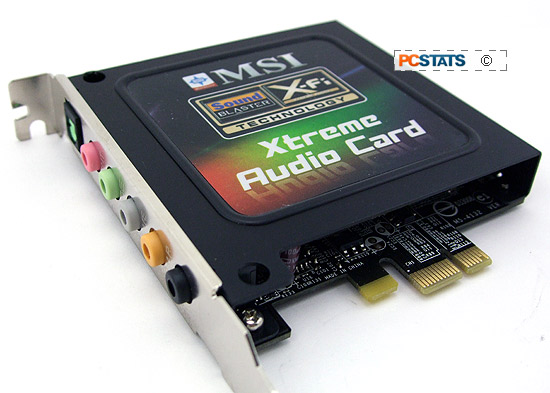
It's been a bit of a trend for 'enthusiast motherboards' to include dedicated buttons on the PCB for powering
up and resetting the system. It's a great tool for the overclocker who's tweaking a
system on a bench or table and shifting a lot of hardware into and out
of the system. MSI has taken this a step further with the X58 Eclipse Plus
motherboard. In the lower right corner you'll find five dedicated hardware buttons
and a knob. I do believe this is the first time I've seen an adjustable
knob on a motherboard.
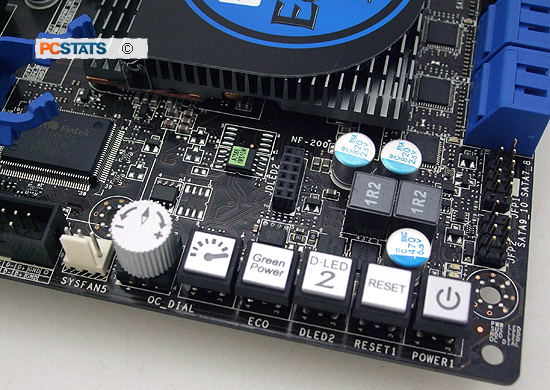
The power and reset buttons are the most obvious in
function, and essential for system control. To the left of them are the D-LED
and Green power buttons. The D-LED button activates an on-board LED display and
changes its modes, while the GreenPower button toggles the X58 Eclipse Plus'
power-saving features. The most exciting keys are the OC Dial knob and the OC Dial button. Hit the OC
button and it lights up, indicating that the system speed can be
increased. Now turn the dial clockwise, and watch the clock speed increase! Once
you're done, hit the OC Button again and the system will apply
the speed increase.
MSI's X58 Eclipse Plus has a whole lot of ways to keep you informed of the
current system status, we'll cover these right after the jump...

